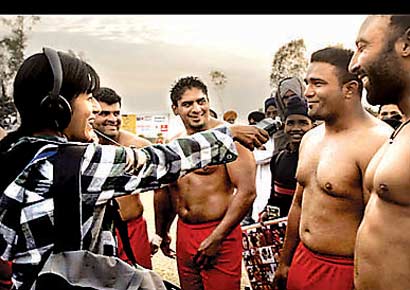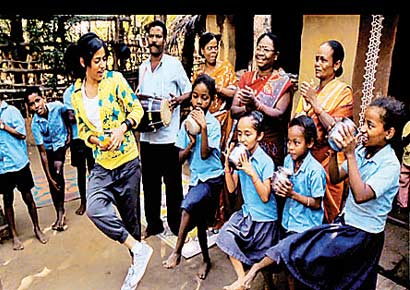
Sneha Khanwalkar likes it when you don’t ask her about ‘how it feels to be a female music director in Bollywood.’ But when you have been consistently proving your mettle with your own kind of sound — one that has the junta loving it enough to play it in weddings (Oye Lucky Lucky Oye); clubs (Love Sex aur Dhoka) and even be appreciated by the older generation (Gangs Of Wasseypur aka GOW), talking about gender is a non-issue.
That aside, the one idea you can’t get wrap your head around, when you are sitting in front of the petite and unassuming music director, is the absence of any angst-ridden struggle story to make it in the ‘big, bad world of Bollywood’.

Sneha in Kila Raipur, Punjab
So, unlike musicians who rue the fact that they had to struggle and stand in queues to meet music directors, Sneha’s route to music direction was rather straight and unencumbered. Actually, it was all just a call away. Recalling it, she says, “I knew I wanted to become a music director, so my first call (ever) was to Tigmanshu Dhulia.” The reason she chose him was because, “I felt that he seemed to be a good person to call. He’d assisted Mani Ratnam and seemed like a sensible director who made films that didn’t conform to mainstream standards,” and that call, in turn led her to work for an unreleased movie and lyricist Piyush Mishra, who immediately introduced her to Anurag Kashyap. “During the course of the meeting, Anurag asked me to sing a song. So I just sang and while he joked ‘meri picture tho release nahin hoti’, he asked me to go meet RGV!” she trills. And within hours, she’d met “Ramu who asked me to compose two songs for a film called Go.” Interestingly, as Sneha reveals, “I’d composed only two songs but the CDs credited me as the music director for all the songs.”
Bagging Love, Sex Aur Dhoka, once again, was as breezy as calling Dibakar and starting off the conversation with, “I want to work with you but I have not watched Khosla Ka Ghosla.” After a funny rejoinder from Dibakar, “It’s ok, not many have watched it either,” the two met and she went on to compose power-packed tunes for the ground-breaking movie. Easy as it all sounds, Sneha points out, rather wisely that “struggle really is internal and you’ve got to be clear about what you want to do” before you set out to do what you want to do.

Sneha in Yellapura, Karnataka
Another interesting facet of Sneha is the fact that unlike most music directors, who are happy sitting in their studios, she is someone who seems happy composing music outside the studio. For instance, she travelled all the way to Trinidad to record the song Hunter for GOW. “I am a little held-back in the studio. I am not a conventional musician and I haven’t had that kind of life. So, though I eventually come back to the studio to work on the song production, I feel the need to get out, record sounds and meet people.”
Philosophising aside, there are other happy topics to be discussed. For instance, her show on MTV called Sound Trippin’, which currently has young India on a tizzy with its original concept and brilliant compositions. The show has Sneha travelling to relatively unknown places in India, to create music from ambient sounds and with local singers who “might never be heard in the cities.”
“The show’s concept is such that we had to record songs in four days,” she says of the challenge the show entailed but a self-confessed nomad, off she went, backpack, recorder, laptop and a small crew in tow, to places as far flung as Leh; Majuli, Assam; Yellapura, Karnataka; Dharavi, Mumbai; Kila Raipur, Punjab, Kolkata and Goa, too. “Music is people,” she strongly iterates and goes on about how, “each place has its music that somehow subconsciously influenced me.” So, where Punjab, is all “grand and loud and inspires chromatic notes,” in Majuli or Kolkata, “the music is pentatonic and pahari” and Bihar inspires “meja, meja, happy tunes”. “The tunes just come automatically,” she says, and adds rather animatedly, “Each state has its favourite ragas and style of throwing voices. So, where you won’t find a Bengali singing in a high-raised voice, in Punjab they are powerful.”
The most fun she had while shooting for Sound Trippin’ was in Kanpur shooting for Phinger where she got a nautanki troupe that specialises in double meaning lyrics to sing for her. “Who goes to Kanpur?” she questions amusingly before remembering how the troupe members, “took a trip of the city-bred boys in the crew with their suggestive jokes.” “I had fun just observing them and prodding the nautanki artistes to tease the boys more,” she jokes.
With the first season of the show over and ideas still being discussed for season two, (if there is going to be one), Sneha’s busy with composing tunes for Gangs Of Wasseypur 2 and is in talks for another movie, which is “too early to talk about.”
Beyond composing music are plans to visit and capture the sounds of places she hasn’t visited, like her own state — Madhya Pradesh, Maharashtra and parts of South India and the North-East. “Travel makes you a thinker, opens your eyes, your ears and teaches you something with every step you take,” she trails off.